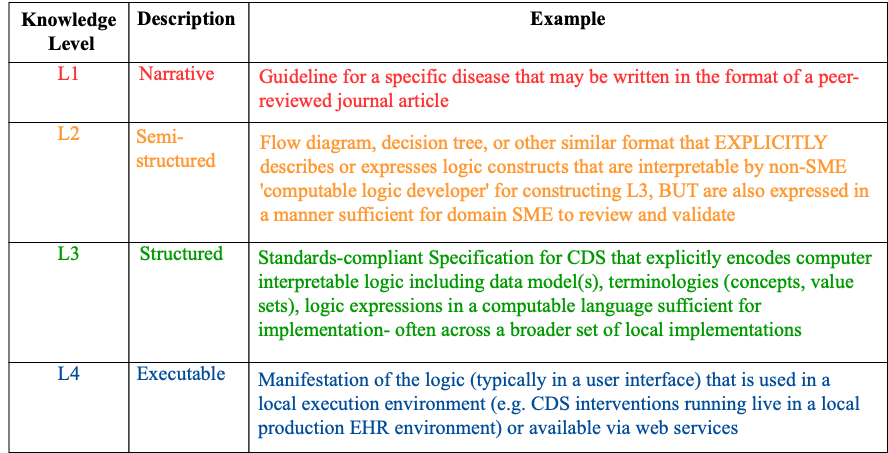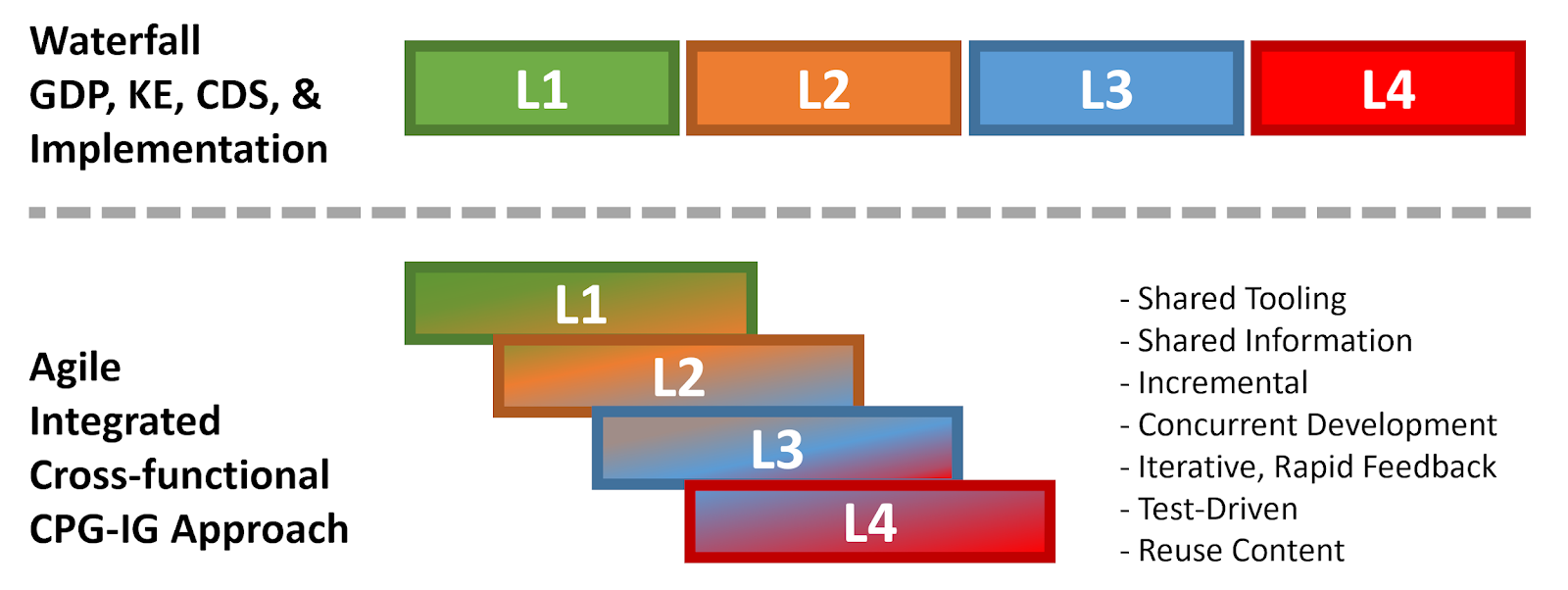This page is part of the Clinical Guidelines (v2.0.0: STU2) based on FHIR (HL7® FHIR® Standard) R4. This is the current published version. For a full list of available versions, see the Directory of published versions
“Levels” of Knowledge Representation Framing
Approach
The approach taken by this implementation guide is to consider three broad challenges of clinical guideline implementation:
Note that the levels of knowledge representation are a continuum, with discrete categories introduced in the methodology to help inform discussions and communicate the concepts involved. Typically, the initial guideline content is published in narrative form (L1), but guidelines will often contain diagrams, charts, and other depictions that lean towards semi-structured (L2) representation.
This implementation guide utilizes a previously established clinical decision support (CDS) implementation model to move from a narrative clinical guideline to computable content. This model defines four (4) ‘levels’ of knowledge representation:
FIG. 47. Knowledge Levels with Examples (Michaels, U.S. Centers for Disease Control and Prevention, 2019; Adapted from: Boxwala, AA, et al.. A multi-layered framework for disseminating knowledge for computer-based decision support. J Am Med Inform Assoc 2011(18) i132-i139).

Narrative
Level 1 (L1) is the clinical guideline in narrative form often in Portable Document Format (PDF), and includes:
- Clinical Focus
- Scope (population attributes from PICOTS, as well as interventions, comparators, outcomes, timing, and setting)
- Recommendations (at least in part from PICOTS interventions)
- Strength of Recommendation and Quality of Evidence
- Evidence references (including analysis and evidence summaries)
- Evidence Summaries
- Tables and FIgures (including drafts thereof)
- Who / what is included (inclusions) for each Recommendation or combinations thereof
- Who / what is excluded (exclusions) for each Recommendation or combinations thereof
- Case Examples (examples of how patient archetypes might traverse the guideline)
- Glossaries- of terms with their descriptions and definitions
- Indicator descriptions
- Policy considerations (e.g., privacy, access, regulations)
- For example, one such guideline is the Guideline for Prescribing Opioids for Chronic Pain (2016) published by the Centers for Disease Control and Prevention (CDC).
Semi-structured
Level 2 (L2) is semi-structured and generally consists of process and workflow diagrams, user stories, and personas that provide contextual and descriptive information about the steps involved in each recommendation of the guideline. This level generally includes:
- Concepts - What are the formal domain concepts involved
- Concept Maps of all the concepts and their relationships as scoped to the guideline
- Visualizations of Processes - (Flow) Diagrams depicting the order of actions and decisions involved, often in parallel to the domain concepts or data elements used as well as workflow and/or potential set of workflow interventions to be employed
- Flow diagrams of information, decisions, and processes
- Decision Trees and Table
- Personas - Who are the actors involved
- User Stories - Functional descriptions of what happens from the perspective of each persona
- Wireframes of potential user interactions
- Triggers - When do the processes happen (i.e., what are the entry points for the processes)
- Terminologies and Data Dictionaries
- Formal definitions for Indicators (e.g., using pseudocode)
- The examples included in this implementation guide illustrate some of the types of content and approaches that can be used for L2.
Structured
Level 3 (L3) is a computable representation of the content in the guideline and can be shared across health systems and implementation settings. This level is the primary focus of this implementation guide and as such throughout much of this implementation guide when we refer to formalized knowledge assets (or formalisms and expressions) we are almost exclusively referring to this level of representation (computable). They generally consists of:
- Complete value sets specified using standard terminologies (coded concepts, code systems, and intentional and extensional value sets)
- Data Requirements
- Data element definitions describing the information involved
- Including inferred data elements
- Computable logic describing, at minimum, the inclusion/exclusion criteria
- Resource definitions with respective terminologies including for the recommended activity itself (e.g. MedicationRequest + Value Set for a recommended medication)
- Structured recommendations with decision logic (in the form of event-condition-action (ECA) rules)
- Structured process definitions describing how the recommendations fit into a clinical workflow (inclusive of decision and orchestration logic such as in CPGStrategies)
- Structured form definitions providing a conceptual description of the user-interactions involved (e.g. Adaptive Forms)
- All the CPG definitional resources (e.g. CPGPathway, CPGStrategies, CPGRecommendations, CPGCaseFeatures, etc.) are Level 3 representations.
Executable
Level 4 (L4) is executable software running in a clinical system (e.g., EHR, registry, exchange, quality measurement module). This is the local implementation and generally involves:
- Mapping of terms (value sets) to local terms
- Adjustment of workflow for site-specific factors
- Interpretation of computable content in the site-specific environment (see Methods of Implementation)
As will be discussed further in the Agile CPG development approach (see section on Knowledge Engineering), these levels of representation may begin to overlap or blur and may not follow an entirely linear or successive progression for sequential development maturation. Furthermore, tooling capabilities may afford translation across levels of representation and some levels may not be entirely expressed as the tools user interface and internal translation capabilities facilitate traversing these levels. This will become more evident and described in more detail in the section on the Agile CPG development approach.
FIG. 48. Levels of Representation in historical CDS sense and as may be adapted for Agile approaches.


